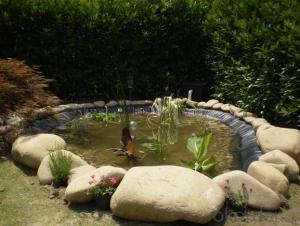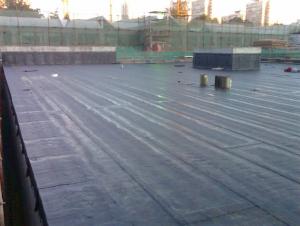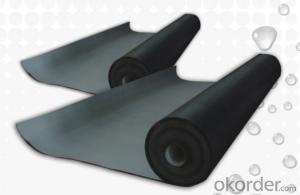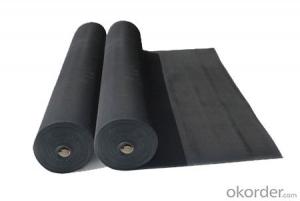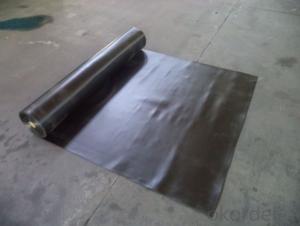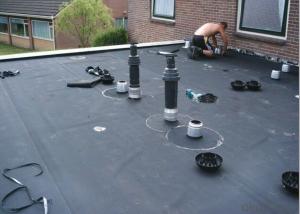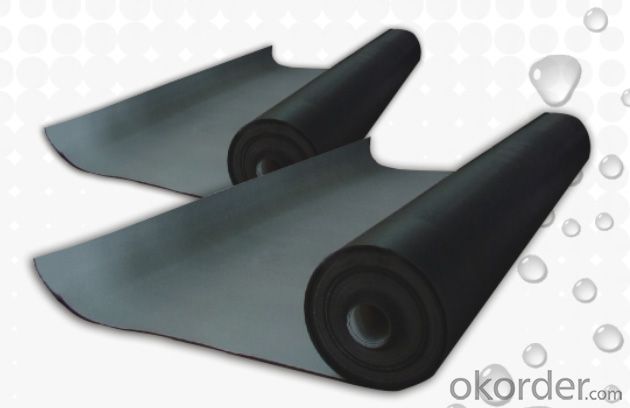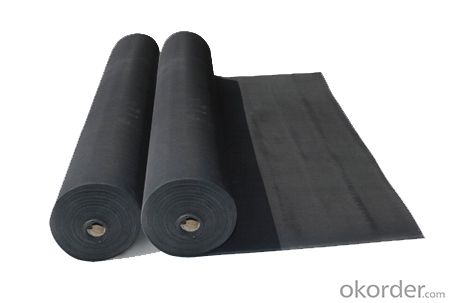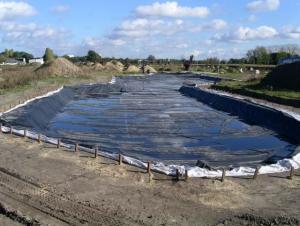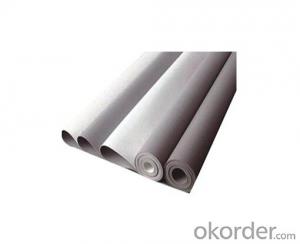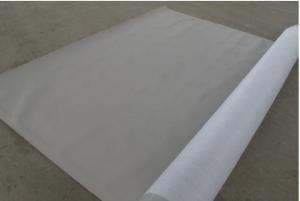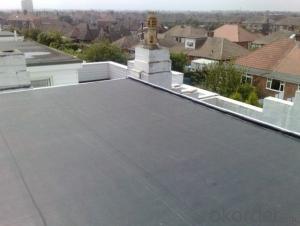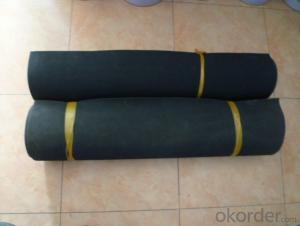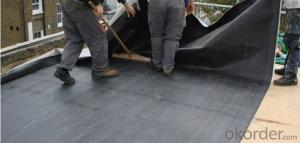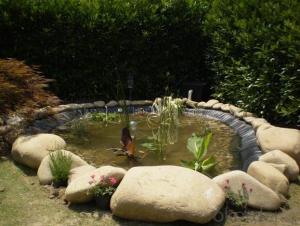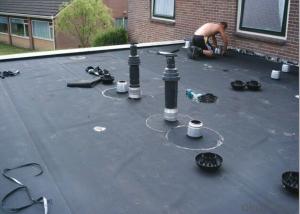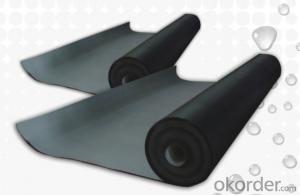EPDM Rubber Material Waterproof Membrane for Tall Building
- Loading Port:
- Shanghai
- Payment Terms:
- TT OR LC
- Min Order Qty:
- 50000 m²
- Supply Capability:
- 5000000 m²/month
OKorder Service Pledge
OKorder Financial Service
You Might Also Like
EPDM Rubber Material Waterproof Membrane for Tall Building
Description Of EPDM Rubber Material Waterproof Membrane for Tall Building:
This waterproof coiled material is of high elasticity with best performance among high polumer waterproof coiled material in the world.It is also the most typical one in the world.Waterproof coiled material made of ternary ethylene-propylene rubber is produced with the use of the most advanced contiuous extrusion and vulcanization technology and related equipments which are specially designed for production of such product.It is good in compactness,without bubble and performance difference in length and breadth,perfomances reach or exceed the demands of GB18173.1-2000 standard.
Main Features of EPDM Rubber Material Waterproof Membrane for Tall Building:
1.EPDM waterproof membrane for bridge engineering waterproof
2.EPDM waterproof membrane for water conservancy projects ,such as river bank,lake dam seepage.
3.EPDM waterproof membrane for the municipal engineering.
4.EPDM waterproof membrane for aquaculture.
Specifications of EPDM Rubber Material Waterproof Membrane for Tall Building:
| Number | Item | Unit | Value | |
| 1 | Size Variation | Thichness | % | ±10 |
| Width | % | ±1 | ||
| Length | % | Allowed negative | ||
| 2 | Breaking tensile strength at normal temperature | Mpa | ≥7.5 | |
| Breaking tensile strength at 70°C | Mpa | ≥2.3 | ||
| 3 | Breaking elongation at normal temperature | % | ≥450 | |
| Breaking elongation at -20°C | % | ≥200 | ||
| 4 | Tear strength | KN/m | ≥25 | |
| 5 | Impermeability(30min) | * | 0.3Mpa no leakage | |
| 6 | Bending at low tempreture | °C | ≤-40 | |
| 7 | Stretch tensor at heating | Elongate | mm | ≤2 |
| Shrink | mm | ≤4 | ||
| 8 | Air oven aging(80°C×168h) | Tensile strength at break retained | % | ≥80 |
| Elongation at break retained | % | ≥70 | ||
| 9 | Anti-alkali | Tensile strength at break retained | % | ≥80 |
| Elongation at break retained | % | ≥80 | ||
| 10 | Nuture weathing at manual simulation | Tensile strength at break retained | % | ≥80 |
| Elongation at break retained | % | ≥70 | ||
Applications of EPDM Rubber Material Waterproof Membrane for Tall Building:
Widely used in roofs, basement, toilet ,swimming pool, and all kinds of industry and civil building waterproofing, reservoir, vivicism, bridge, underground, tunnel and dam waterproofing ,especially to the keystone waterproofing projects which is durability, high corrosion resistance and easy deformation.



IMages of EPDM Rubber Material Waterproof Membrane for Tall Building:




FAQ of EPDM Rubber Material Waterproof Membrane for Tall Building:
1. What are we supplying?
We are specialized in producing Colorful Asphalt Roof Shingle, SBS/APP modified bitumen waterproof membrane, Self adhesive bitumen waterproof membrane, PVC waterproofing membrane, EPDM rubber roofing membrane, Single Component Polyurethane Waterproof Coating, and Spray Polyurea Waterproof Coating
.
2. How Many years experience do we have?
We have been exported to more than 20 countries in the past 15 years.
3. How long do we usually reply your request?
We always reply our customer within 24 hours.
- Q: Can waterproofing membranes be painted over?
- Yes, waterproofing membranes can be painted over. However, it is important to ensure that the paint used is compatible with the membrane material. It is recommended to consult the manufacturer's guidelines or seek professional advice to ensure proper adhesion and longevity of the paint. Additionally, the surface should be clean and dry before applying the paint to ensure optimal results. Overall, painting over a waterproofing membrane can help enhance its appearance and provide additional protection against UV rays and other environmental factors.
- Q: Can a waterproofing membrane be used for HVAC systems?
- No, a waterproofing membrane is not suitable for HVAC systems as it is specifically designed to prevent water penetration and does not have the necessary properties to regulate air flow or temperature control required by HVAC systems.
- Q: Can a waterproofing membrane be used on swimming pools?
- Yes, a waterproofing membrane can be used on swimming pools. In fact, it is a common and effective method for ensuring the pool remains watertight. Waterproofing membranes are typically made of materials such as PVC or rubber and are specifically designed to prevent water from seeping through the walls or floor of the pool. These membranes are applied as a thin layer or sheet over the pool's surfaces, creating a barrier that keeps water contained within the pool. This helps to minimize the risk of leaks and water damage, ensuring the longevity and functionality of the swimming pool.
- Q: Can a waterproofing membrane be used on hollow core block surfaces?
- Indeed, the utilization of a waterproofing membrane is possible on hollow core block surfaces. Waterproofing membranes are a widely employed measure to safeguard various surfaces against water infiltration and subsequent harm, encompassing surfaces composed of concrete and masonry. Hollow core block surfaces, being constructed from concrete, are not an exception to this practice. The application of a waterproofing membrane onto the exterior of hollow core blocks can effectively shield them from water intrusion and potential damage caused by moisture. This becomes particularly crucial in regions where exposure to water is frequent, such as basements or subterranean structures. However, it is of utmost importance to ensure that the specific waterproofing membrane chosen is compatible with hollow core block surfaces and that proper installation techniques are adhered to in order to attain optimal outcomes and long-lasting protection.
- Q: Can a waterproofing membrane be used for concrete bridge decks?
- Yes, a waterproofing membrane can be used for concrete bridge decks. A waterproofing membrane is a thin layer of material that is applied to the surface of the bridge deck to prevent water infiltration and protect the concrete from deterioration caused by moisture. This membrane is designed to be flexible and durable, providing a barrier against water while allowing for the movement and expansion of the bridge deck. It is typically applied in multiple layers and can be either hot-applied or cold-applied, depending on the specific project requirements. The use of a waterproofing membrane on concrete bridge decks helps to extend the service life of the structure by preventing water damage, reducing the need for frequent repairs and maintenance, and improving overall structural integrity.
- Q: Are waterproofing membranes resistant to hydraulic oils?
- Waterproofing membranes are typically not resistant to hydraulic oils. Hydraulic oils are designed to be highly lubricating and can often penetrate and degrade the integrity of waterproofing membranes. Therefore, it is important to ensure that if hydraulic oils are present in an area where waterproofing is required, additional protective measures, such as using chemical-resistant membranes or applying suitable coatings, are taken to prevent any potential damage to the waterproofing system. It is always recommended to consult with a professional waterproofing contractor or manufacturer for specific recommendations regarding the compatibility of waterproofing membranes with hydraulic oils in a particular application.
- Q: Are waterproofing membranes resistant to chemical solvents?
- Yes, waterproofing membranes are generally resistant to chemical solvents. They are designed to provide a barrier against water and other liquids, including chemical solvents, to prevent leakage and damage to the underlying structure.
- Q: Are there any specific considerations for installing a waterproofing membrane in high-traffic areas?
- Yes, there are specific considerations for installing a waterproofing membrane in high-traffic areas. Firstly, the membrane should be durable and able to withstand heavy foot traffic without getting damaged. It should also have a non-slip surface to ensure safety and prevent accidents. Additionally, the membrane should be easy to clean and maintain to prevent dirt build-up and maintain its functionality.
- Q: Can a waterproofing membrane be used in areas with heavy rainfall or high water tables?
- A waterproofing membrane is suitable for use in regions experiencing heavy rainfall or having high water tables. It is specifically crafted to prevent the infiltration of water and effectively shield structures from water damage. These membranes are constructed using materials like bitumen, rubber, or polyurethane, which serve as a barrier against moisture. They are installed on the exterior side of walls, roofs, or foundations to establish a tight seal against water. To cope with the constant exposure to water in areas with heavy rainfall or high water tables, it is crucial to employ a top-notch and long-lasting waterproofing membrane. Moreover, it is essential to ensure the effectiveness of the waterproofing system through proper installation techniques and regular maintenance.
- Q: Can a waterproofing membrane be used for water treatment plants?
- Yes, a waterproofing membrane can be used for water treatment plants. Waterproofing membranes are designed to prevent the passage of water and can be used to provide a barrier against water leakage in various structures, including water treatment plants. These membranes can be applied to different areas of the plant, such as tanks, reservoirs, pipes, and basements, to prevent water infiltration and protect the infrastructure from potential damage. Additionally, waterproofing membranes can help maintain the integrity of the water treatment process by ensuring that water remains contained within designated areas and does not seep into surrounding soil or structures.
Send your message to us
EPDM Rubber Material Waterproof Membrane for Tall Building
- Loading Port:
- Shanghai
- Payment Terms:
- TT OR LC
- Min Order Qty:
- 50000 m²
- Supply Capability:
- 5000000 m²/month
OKorder Service Pledge
OKorder Financial Service
Similar products
Hot products
Hot Searches
Related keywords
